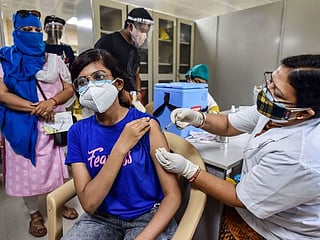A ‘third wave’ of COVID-19 can’t be predicted for India yet, says top WHO scientist Dr Soumya Swaminathan
Dr Soumya Swaminathan: See the COVID ‘wave’ not as something coming at us, but from us

Also In This Package
Kolkata: From a daily peak of 400,000-plus cases around the middle of May to a little over 100,000 positive cases of coronavirus infections yesterday, the infectivity rate in India, the worst-hit country in the ‘second wave’ of COVID-19, has shown some very encouraging decline over the last two weeks, thereby indicating that the worst may have been over — for now. While a drop in the infection rate is a definite positive sign, it is also a worry because this may once again lead to the same slackening of the protective measures among the public that had seen such horrific tales of death and helplessness unfold before our eyes in the month just gone by. Some experts have also warned that a ‘third wave’ is imminent for India.
Gulf News caught up with Dr Soumya Swaminathan, Chief Scientist, World Health Organisation (WHO), for a better understanding of where exactly India and the world stand in fighting this scourge. Following are excerpts.
GULF NEWS: Why has the ‘second wave’ of COVID-19 turned out to be so lethal for India?
DR SOUMYA SWAMINATHAN: Wherever you have intense transmission of the SARS-COV-2 virus, causing large numbers of people to get infected, there will be greater numbers of people who develop severe illnesses needing hospital admission and intensive care. No health system in the world has the capacity to deal with so many needing intensive care at the same time. So, unfortunately, when community transmission becomes intense, hospitals get overwhelmed quickly as they lack the staff and the supplies to deal with every person who needs care. So you will see a rise in deaths — both from COVID-19 and other causes.
We have seen surges like this happen time and again in different countries. This virus can take off when it finds an opportunity. Nobody can know for certain, at this time, what the exact cause is. It is likely to have been caused by a combination of factors, including relaxing of personal protective measures, more social mixing, mass gatherings, the circulation of more contagious variants while vaccine coverage is still low.
Right now, we need to jointly focus on filling gaps in medical supplies and hospital capacities, taking the heat out of the widespread transmission, and thereby saving lives.
We need to be patient. We have the tools to overcome this viral pandemic and it is only a matter of time.Dr Soumya Swaminathan, Chief Scientist, World Health Organisation
Question: Is a ‘third wave’ imminent for India?
Answer: We cannot predict whether this will happen, but we do know that transmission can be brought under control. What people call a ‘wave’ is not something coming at us — rather, it is coming from us. Human behaviours spark the rise in cases such as by social mixing, people from different groups and places gathering together in closed settings, with poor ventilation, not wearing masks, not washing hands, not opening windows etc. Equally, health authorities need to step up identification of the virus by increasing testing and enabling people to quarantine to break the chains of transmission. Stopping the outbreak will depend upon the actions at all levels: Individual, local, national and international.
I’d say that India can prevent future waves of this virus.
Question: What are the three key steps that India needs to take to bring the situation under control?
Answer: — Increasing the rate of vaccination
— Limiting social mixing.
— Increasing testing, tracking, tracing and supporting isolation of those who are testing positive and quarantining of those identified as contacts in order to break the chains of transmission.
Question: As a medical expert, what will your advice be to a common man or woman anywhere in the world at this juncture?
Answer: Listen to the advice about protecting yourself and avoid the 3 Cs: Crowded places, Close contact with others, and Confined places with poor ventilation.
Always wash your hands, carry an alcohol-based hand-rub and whenever you are in crowded places or indoors with other people who are not from your household, wear a mask.
Question: How important is hospital care, given that medical facilities almost everywhere in the world are stretched to their limits?
Answer: My advise is: Don’t rush straight to the hospital. Instead, seek local care and support. The decision about whether you will need hospital care will depend on your symptoms, requirement for supportive care, potential risk factors for severe disease and conditions at home — including the presence of vulnerable persons in the household. Only 15 per cent of people will need hospital care and oxygen, but it is important that you or those caring for you know how to monitor the course of an illness and seek care at the right moment. Signs and symptoms of complications that may need hospital care include chest pain, shortness of breath, light headedness, persistent fever, nausea and vomiting.
But we need to be patient. We have the tools to overcome this viral pandemic and it is only a matter of time.
Sign up for the Daily Briefing
Get the latest news and updates straight to your inbox








